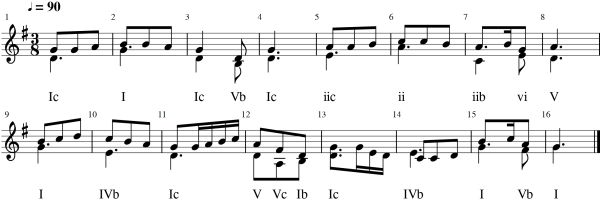Audio: harmonisation (0:16)

harmonisation plays a reharmonised melody on an accordion in the key of G. The harmonisation figure shows the score. The original melody is in the upper part and the harmony is in the lower part. The melody is an old English folk song called Who's the Fool Now? It was published in 1609 by Thomas Ravenscroft.
Harmonisation is the process of adding harmony to a melody.
Many of the methods for harmonisation are covered in detail elsewhere in the guide. Any or all of them can be used to harmonise a melody. Here is a summary of how to apply them:
This chapter looks at another method of harmonisation: using chordal harmony to add chords to a melody.
There are a couple of things to do before starting harmonisation. First, analyse the melody for clues. Determine the key, if it is not known. Common clues are that the melody often starts and ends on the tonic and that the tonic is frequently repeated. Determine the time signature too, if it is not known. Then look for nonscale notes as evidence of a chromatic chord (there are none in harmonisation). Next, decide your approach. You might prefer to write two part harmony first (as was done when writing harmonisation) and figure out the chords afterwards. Or you might prefer to notate the chords first then choose one or more notes from each chord as the harmony. Either approach works well.
The principles of harmonisation are to let the melody determine the harmony and to keep the harmony as simple as possible. The process is straightforward: decide where to place a harmony note, determine its pitch, and notate the chord.
Placement of a harmony note generally follows the rhythm of the melody. There are three rhythms in harmonisation. ONE-two-three is evident in most of the bars and all that is required is a harmony note on the first beat in each bar. ONE-two-THREE is evident in some bars and a harmony note is added to the first and third beats, as in bars 3, 7 and 15. In bar 12 the rhythm is ONE-TWO-THREE and all three notes are harmonised.
Now decide the pitch of the harmony note. In tertian harmony, the interval between the notes in the harmony and the melody will be unison, third or sixth, or fifth or fourth. Although the interval of a fourth is treated as dissonant in counterpoint and its use is forbidden, it can be freely used in noncontrapuntal harmony, and harmonising a fourth below is common in folk music. The intervals of second and seventh can also be used, except they cannot be harmonised with a triad, and will require another type of chord.
Finally, notate the chord, and, if required, add more notes to the harmony. Chords are notated below the staff in harmonisation to enable the harmony to be expanded to three parts. The chords that are used are I, the tonic chord, ii, IV, V and vi. Often, all that is needed to harmonise a melody in a major key are I IV and V chords. Use inverted chords freely to create variety in the harmony.
The chordal approach in harmonisation adds a new harmony to an old melody in a process known as reharmonisation. This is one of the fun bits in writing music. Someone else has written the melody so the hard work has been done. All you have to do is add the harmony. Folk music in particular is an excellent source of melody for reharmonisation. It is a form of community music, much folk music is handed down throughout the ages, and singers and musicians are encouraged to innovate and adapt old melodies to new forms. Copyright may be also be less of a problem if you decide to publish your reharmonised masterpiece.